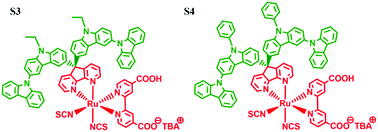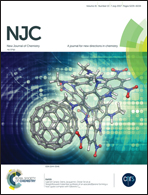Ruthenium(ii) complexes incorporating carbazole–diazafluorene based bipolar ligands for dye sensitized solar cell applications†
Abstract
In this research work, new types of ruthenium sensitizers used in dye sensitized solar cells (DSSCs), named S3 and S4, consisting of carbazole–diazafluorene based bipolar ancillary ligands, have been synthesized and characterized by 1H NMR, UV-vis absorption spectroscopy, and elemental analysis. The energy levels and band gaps of the sensitizers were evaluated using electrochemical measurements and density functional theory (DFT) calculations. Both sensitizers show blue shifted low energy metal to ligand charge transfer bands, which could be ascertained from the relatively large dihedral angle between the secondary electron donor (carbazole) and acceptor (4,5-diazafluorene) units. The frontier molecular orbital surfaces obtained from DFT calculations revealed that the highest occupied molecular orbitals (HOMOs) of both sensitizers are dominantly populated on the secondary electron donor carbazole antenna, indicating the increased spatial separation of the HOMO away from the TiO2 surface. The DSSC fabricated using sensitizer S4 exhibited a higher photon-to-current conversion efficiency (2.11%) and these results were compared to those obtained with commercial sensitizer N719. The implications of this study may contribute to the design of new molecular architectures to be applied in DSSCs.



 Please wait while we load your content...
Please wait while we load your content...